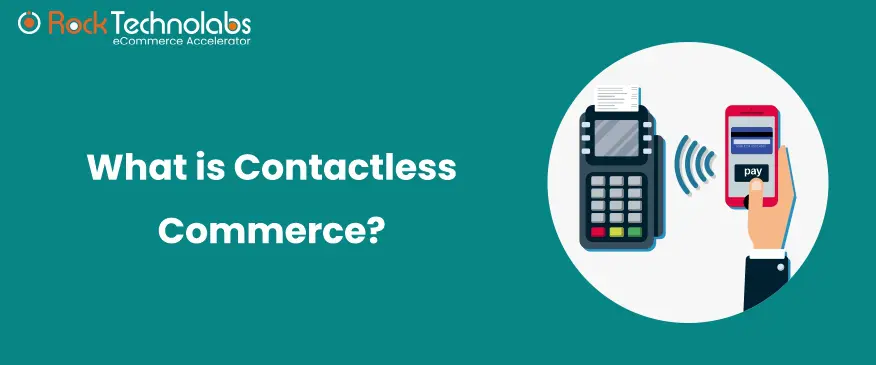Contactless Commerce – How Businesses Are Preparing For A Post Covid Shopping Experience For Customers

The Covid-19 pandemic & the social distancing has put further strain on traditional retail. It was an ultimate test for many of these fundamental aspects of the customer experience: no contact with retail agents, no fitting rooms, no in-store testing of products, and no cash payments. Many stores have now reopened in the wake of the pandemic, and the retailers have learned an important lesson: we need safer, faster, and better in-store experiences for customers and enhance the interactivity with agents, products, and the store environment.
This is where a new era of digital commerce can make a massive impact, and “contactless commerce” is one of them. ‘Contactless commerce’ is certainly one of the buzzwords in recent times, you won’t be able to avoid in 2022. But what does it really mean? And what does it mean for businesses across the world? Could your business be able to survive another pandemic if you do not have contactless commerce built into your business?
What is contactless commerce?
In the current moment we live in, “contactless” is not just a buzzword. It has made so much sense than ever before. Contactless commerce means recreating the in-store experience digitally. It is not only about curbside pickup, but it’s more about product discovery, content discovery, in-store kiosks, self-service, and more. All these elements help to virtually remove the direct human interaction, yet allow the customer to search and get all the information about what they are looking for. So here it is – a much broader and precise definition than just fulfillment.
Contactless commerce includes various forms and is being enabled by a wide range of new technologies, including robotics, machine learning, sensors, computer vision, augmented reality, big data analytics, and computer-aided holography. It is set to transform all elements of the contactless customer experience, from comparing products to selecting products to check out.
Now the question is why is it called contactless? So let us inform you that just like contactless cards, Contactless Commerce allows contactless transactions to be made without touching anything. In the purchase process, the consumer is not forced to touch any device. This new trend will be 80% of product ordering and refill systems already in 2024 in most companies.
What will those contactless items be? Payment systems, which are now routine, but also product collection services, deliveries, or payment boxes for in-store purchases.
Touchless retail can be defined as the mechanism which involves zero human intervention across end-to-end customer buying processes. It also covers different concepts like BOPIS, Contactless Payments, eCommerce, Curbside Pickup which can be classified under the broad category and leverage a unique technology stack.
BOPIS: Buy online, pick up in-store
BOPIS contactless option is just like heaven where customers can simply skip the line, the product browsing at stores, the mingling with and coming in contact with other shoppers and just go straight to the check-out counter where all the products they have purchased online are waiting for them to pick up at their own convenient time. This will minimize the contact made between retailers and customers, as well as other shoppers.
Curbside Pickup:
Curbside pickup is not so different, but in this, only the delivery location gets changed. It’s usually the retail store instead of the customer’s address. They can either place an order on the phone or make a purchase online, and then meet a representative at a given retailer’s address or outside their store to pick up their order. In this option, the contact is made between the employee and customer during the exchange, and this makes it a really safe option for customers who want to complete their order without entering into proximity with other shoppers.
Contactless Retail is the Future! Here are a few of the reasons:
- Contactless transactions have increased by 40% in the first quarter of 2020.
- The contactless payment market is projected to nearly triple in value by 2026.
- 57% of consumers globally say they will continue to use touchless payment options even after the global pandemic subsides and 74% of retailers state they will continue to use contactless post-pandemic
Source: Contactless Payment Statistics for 2022
Here are some of the ways that merchants can reduce direct human contact and risk while keeping the flow of services and products going during an outbreak scenario:
1. Contactless payments
People use less cash now, and we have seen that after the pandemic, there is an accelerated shift from cash to digital payments because of demand and availability in cashless payment options like mobile payments, contactless card readers, QR codes, wearable tech, etc. as per their needs. This contactless technology offers a wide range of opportunities for customers and brands. It offers flexibility for customers to choose how they would like to make payment as per convenience and also help businesses for enhancing operations by making transactions faster.
Consumers are using mobile wallets, “tap and pay”, and other contactless payment options in the fear of becoming infected with the virus. They find that contactless cards are the most convenient and the safest way to make everyday purchases. These contactless options are quickly being implemented by both consumers and businesses.
Brands that adopted contactless commerce:
1. Amazon’s Just Walk Out technology has been established and used by customers on Amazon’s own stores, where the store can easily track the products taken by customers physically from the shelf or return them back based on the aid of sensors and computer visit. This will simply add it to the virtual cart or take it away on returning.
2. Contactless Payment Methods have been established by many of the major financial institutions in the UK. A feature named Barclays’ “contactless cash” allows customers with an account to withdraw cash by just simply tapping their card on an ATM’s reader machine.
3. Another example is Walmart, where customers can scan the QR to complete their purchase using the Walmart app on their smartphones.
Examples of Contactless Payments
Several payment methods are used for contactless payments. Two of the most common forms of payment used by consumers to pay for products and services are:
- Tap and Pay: This is one of the best payment methods, where customers just need to tap their credit or debit cards over the POS system.
- Mobile Wallets: Another method is mobile wallets, where customers can store their financial information in wallets so that they can easily access it through apps on smartphones or other devices. Some of the most common Mobileile wallets are Mobile Banking Apps, Apple Pay, Android Pay.
Contactless payment options offer many benefits for both customers and businesses.
Benefits For Businesses:
- No Additional Cost
- Enhanced Consumer Experience
- Improved Efficiency
- Fraud Protection
Benefits For Consumers:
- Contactless Shopping Experience
- Convenience
- More Reliability
- Easy to Use
- Loyalty Programs
- Time-saving
2. Omnichannel experiences
The rise in online shopping and digital channels is clearly visible, but omnichannel shopping is one of the tech-focused features which has been in demand. Omnichannel experiences allow customers to purchase online and pick up in-store or curbside pickup, depending on their convenience and preference. This helps customers to get a faster experience than waiting for home delivery for ordered products.
After making online purchases, customers want their orders to be delivered faster than ever before. And if you succeed in offering this contactless and omnichannel solution to this need, you will easily win against competitors. Digital will always remain the priority going forward.
So, brands need to think for the long term when it comes to the features and functionalities of eCommerce sites, to future-proof their business operations and drive sales for customers who want the versatility that omnichannel delivers.
3. Leverage data for personalized customer experience
Customers love personalization. Retailers will increasingly be using data to make billions in productivity, build personalized offerings to customers, boost sales, and provide tailored shopping experiences to your customers. Data drive enhanced customer experiences as it helps merchants to personalize the shopping experience for each buyer.
Brands can start to personalize the shoppers’ experience if they have a holistic customer data set available for analysis. The strategy to use data for business will play an important role in 2022.
Contactless retail in a nutshell
The market is changing rapidly. It’s never too late to adopt something new, you can still create a seamless contactless shopping experience for your customers. Retailers should consider new ways to market their products, develop and promote contactless ordering along with pickup channels, and enhance the in-store checkout experience of customers. Customers are already adopting these behaviors, so all touchpoints should be considered, including online ordering to delivery or pickup.
There are online solutions that allow you to send instant, personalized, and secure payment requests to customers via mobile phones, email, and other messaging channels. Such payment request systems lead to virtual interaction and completely remove the need for any physical contact. All technology should be easy to use, seamless, and clearly communicated with customers. Retailers who can integrate these new techniques, and provide their customers a better shopping experience, will easily grow and expand in this new contactless environment. If you are interested to learn how Rock Technolabs can help you create a meaningful experience for commerce, contact us.


